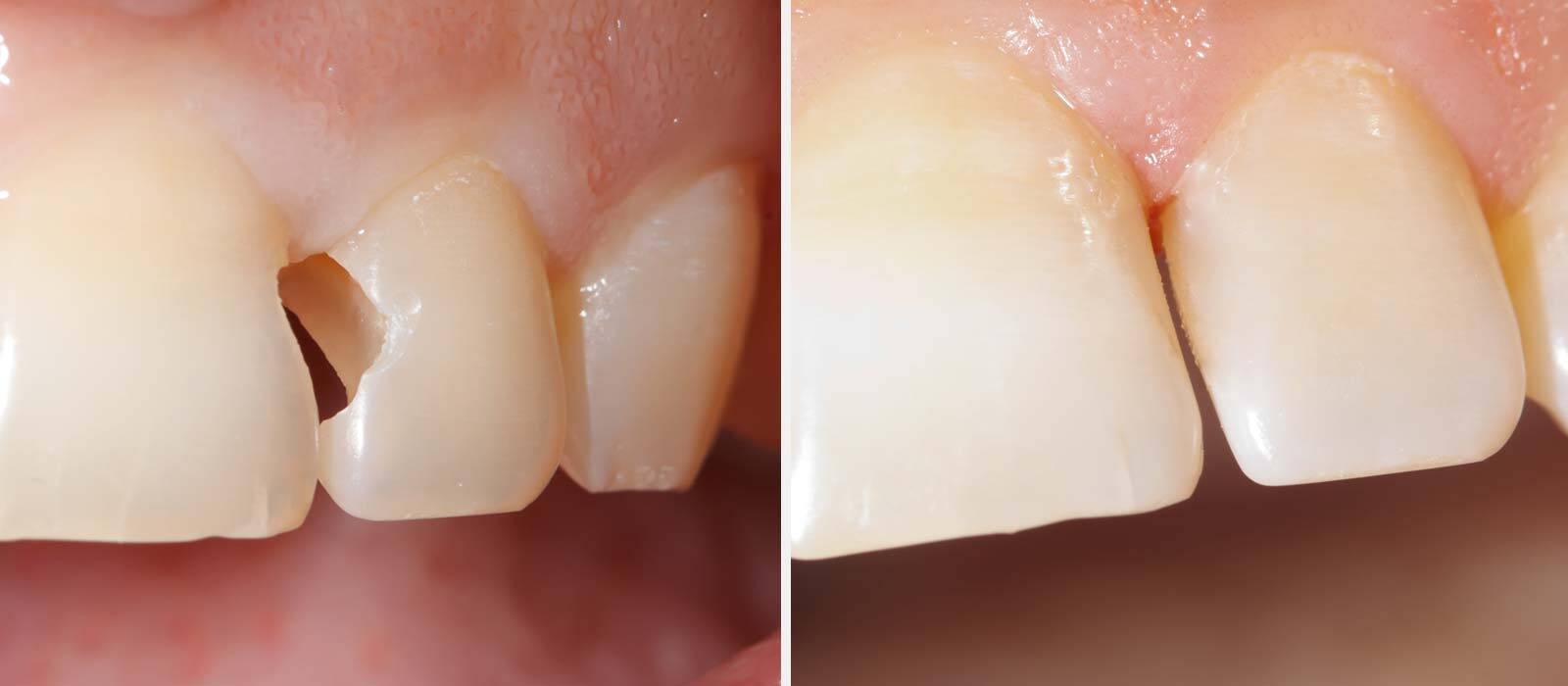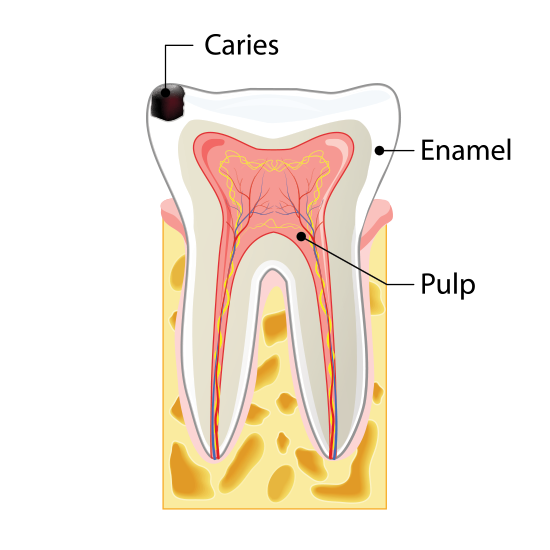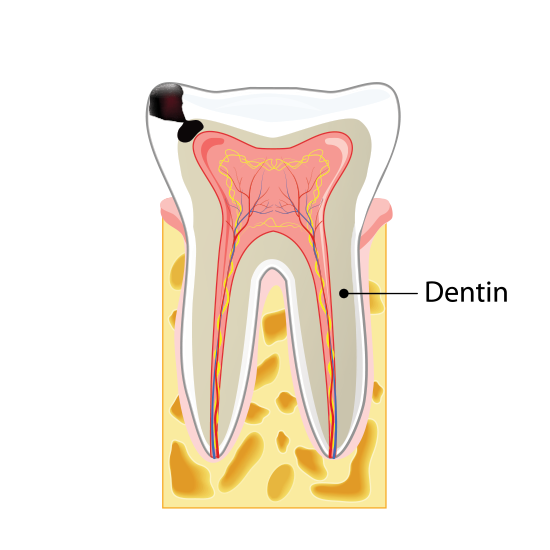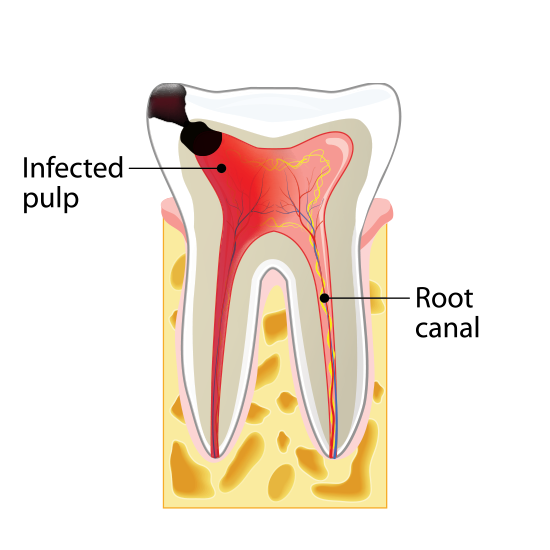Treat & Save Your Tooth with Dental Fillings
Dental fillings are materials used to repair and restore teeth damaged by decay or other types of trauma. The decayed or damaged portion of the tooth is removed, and the resulting cavity is filled with a material to prevent further decay or damage and restore the tooth’s function and shape.
Dental fillings can be made of various materials, such as amalgam (a mixture of metals), composite resin (a tooth-coloured material), porcelain, or gold. The choice of material depends on the location and extent of the damage and the patient’s preferences.
Dental fillings are a common and effective way to treat cavities and restore damaged teeth. Regular dental check-ups and good oral hygiene can help prevent the need for dental fillings in the first place.
For minor cases and preventative dental measures, our dentists may recommend dental fissure sealants as a form of treatment.

dental fillings help preserve your natural tooth
The process of getting dental fillings

Diagnosis and Preparation

Filling Material Placement

Final Steps
Types of Dental Fillings
There are several types of dental fillings, each with advantages and disadvantages. The filling recommended by our restorative dentist will depend on the size and location of the cavity and your individual dental health needs. Some common types of dental fillings include:
- Composite fillings: Composite fillings, also known as tooth-coloured fillings, are made from glass and plastic. They match the colour of your natural teeth and are less noticeable than amalgam fillings. They are versatile and can repair chipped, broken, or decayed teeth.
- Ceramic fillings: Ceramic fillings are made of porcelain and are custom-made to match the colour of your natural teeth. They are strong, durable, and more resistant to staining than composite fillings. However, they are more expensive than other types of fillings.
- Glass ionomer fillings: Glass ionomer fillings are made from glass and acrylic. They are tooth-coloured and can release fluoride to help prevent further tooth decay. However, they are less durable than other fillings and may need to be replaced more frequently.
- Amalgam fillings: Amalgam fillings, also known as silver fillings, are made from a combination of metals, including silver, tin, copper, and mercury. They are durable, long-lasting, and can withstand the force of chewing. However, they are not tooth-coloured and may be visible when you talk or smile.
- Gold fillings: Gold fillings are made of gold, copper, and other metals. They are strong, durable, lasting 15-20 years or more. However, they are expensive and may be more noticeable than other fillings.
Your nearest restorative dentist can recommend the best type of filling for your needs based on the size and location of the cavity, your budget, and your preferences.
Check-ups Help Diagnose & Treat Cavities Before They Worsen
Regular check-up & cleans are crucial to maintaining good oral health. By getting a check-up and clean every six months, our dentists at Amazing Smiles can diagnose and treat cavities in their earliest stages. This helps prevent the cavity from worsening and saves patients from experiencing more extensive and costly treatments in the future.
Regular check-ups and cleans also allow our dentists to detect any signs of gum disease or other dental issues that may be developing, allowing for early intervention and treatment.
Overall, regular check-up and cleans are an essential part of maintaining optimal oral health and preventing serious dental problems.
Why Choose Us for Dental Fillings?
At Amazing Smiles, we pride ourselves on being a family-friendly practice, creating a warm and welcoming environment for patients of all ages.
Our team of skilled professionals is dedicated to providing affordable dental fillings and other teeth restoration options to ensure your oral health and well-being. We swiftly diagnose and treat dental caries with precision and care.
Our compassionate team understands the anxiety of dental procedures, and we strive to make your experience comfortable and stress-free.
When you choose Amazing Smiles, you can expect personalised attention and a comprehensive approach to diagnosing and treating dental caries.
We use modern techniques to accurately assess the extent of the decay and provide you with the most suitable treatment options.
Don’t let dental caries compromise your oral health. With dental clinics on the Gold Coast, Logan, Bray Park, Wynnum and Jimboomba, visit Amazing Smiles today and let our experienced team restore your smile with affordable dental services.
Your oral health is our priority; we are here to provide the compassionate, high-quality treatment you deserve.
Treat Cavities Before They Worsen
Stages of Dental Cavity Development
It is crucial to fix cavities as soon as possible to prevent further damage to your teeth and gums. If left untreated, cavities can lead to tooth loss or gum disease.
What to expect when getting a dental filling?
When getting a dental filling, expect these steps:
- Numbing: A Local anesthetic is applied to numb the area.
- Decay removal: The dentist removes the decayed part with a drill or laser.
- Tooth preparation: The tooth is shaped to create space for the filling.
- Placing the filling: Filling material (composite resin, amalgam, or ceramic) is applied and shaped.
- Curing and polishing: The filling may be cured with a light and polished for comfort.
Our dentists prioritise your comfort and use techniques to minimise discomfort. Temporary sensitivity may occur afterwards but typically resolves within a few days. Proper oral hygiene, including regular check-ups, is essential to maintaining your filling and preventing future cavities.
How much does a dental filling cost?
The cost of a dental filling in Australia typically ranges from $200 to $500 for a simple composite resin filling, depending on the size and location of the cavity. More extensive procedures, like crowns or root canals, can cost between $1,500 and $2,000. Prices may vary based on case complexity. After an initial check-up and clean, our general dental team can provide an accurate quote for your dental filling treatment.
Can a dental filling be claimed using CDBS?
Yes, the Child Dental Benefits Scheme by the Australian Governemnt covers the following services for eligible kids:
- X-rays
- Scale and Cleans
- Fillings
- Root canal treatments
Are their any risks with dental fillings?
Dental fillings, though uncommon, come with some risks. The main risk is an allergic reaction to the material, potentially causing swelling and itching. There is also a chance of damaging the tooth nerve, leading to sensitivity or pain. In rare cases, fillings can come loose or fall out, and infections may occur if bacteria enter the site. Using quality materials and practising good dental hygiene can help reduce these risks. It’s essential to discuss any concerns with your dentist before getting a filling.
What is the difference between dental filling and composite bonding?
Dental fillings and composite bonding restore damaged teeth but differ in application. Fillings remove decay and fill cavities with materials like amalgam or composite resin, which are suitable for moderate to severe damage and provide durability. Composite bonding uses tooth-colored resin to address minor issues like chips or gaps. It requires less tooth removal but typically lasts shorter and requires more frequent touch-ups.
My filling has broken and fallen out, what do I do?
If your dental filling falls out or breaks, take the following steps:
- Contact Your Dentist: Call your dentist immediately to schedule an appointment and explain what happened.
- Protect the Tooth: Avoid eating or drinking anything hot or cold to prevent further damage and sensitivity.
- Clean the Area: Rinse your mouth gently with warm saltwater to keep the area clean and reduce the risk of infection.
- Preserve the Filling: If the filling is intact, store it in a clean container or wrap it in moist gauze or tissue to bring to your appointment.
- Avoid Temporary Fixes: Don’t use over-the-counter dental cement or temporary fillings, as they can interfere with proper dental treatment.
Always seek professional dental care promptly to address the issue and restore your tooth.
Is there a warranty on dental fillings?
At Amazing Smiles, our dental professionals aim to deliver high-quality care and durable restorations. However, we do not offer warranties on dental fillings because several factors affect their longevity.
- Patient Responsibility: We can’t monitor how patients care for their teeth at home. Good oral hygiene, consistent brushing, flossing, and avoiding harmful habits is crucial for the health of fillings.
- Daily Oral Health Habits: The effectiveness of dental fillings depends on your daily oral care. While we provide guidance, we can’t oversee your habits. Any lapse can lead to new decay or damage.
- Dietary Choices: Your diet significantly impacts oral health. Foods high in sugar and acidity can increase the risk of decay and erosion. We recommend healthy eating, but we can’t control your choices.
By practicing good oral hygiene, following dietary advice, and keeping regular dental appointments, you can extend the life of your fillings and reduce the need for replacements.
Why are dental fillings more costly than dental fissure sealant treatment?
Dental fillings are generally more expensive than fissure sealants for several reasons. First, fillings involve more complex procedures, including removing decayed tooth structure and using materials like composite resin or amalgam, which require more time and skill. Second, fillings treat existing cavities, while sealants are preventive for healthy teeth. Finally, fillings often use advanced materials that can be costlier than those used for sealants. For specific costs and personalized treatment plans, it’s best to consult a dentist.
We accept all major health funds

Make an Enquiry
We are proud to be preferred providers with most major health funds, allowing our patients to maximise their health cover benefits and access quality care at greater value. To make treatment more accessible, we also offer a variety of flexible payment plans, helping individuals manage the cost of their dental care in a way that best suits their financial situation.
Start your journey toward a healthier, more confident smile by booking your complimentary smile consultation with Amazing Smiles today.




